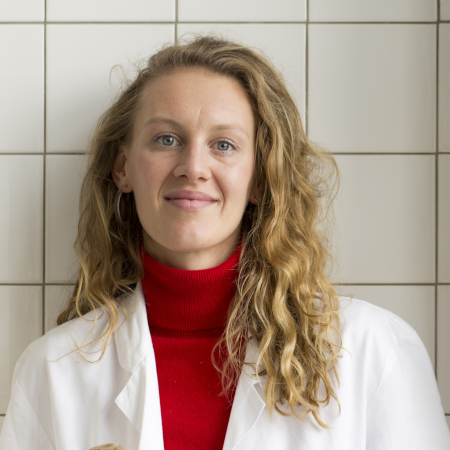The smut whisperer
Jan SchirawskiProfession:
PhD in genetics and chemistry
Position:
Professor of Genetics at the Friedrich-Schiller-University Jena

Profession:
PhD in genetics and chemistry
Position:
Professor of Genetics at the Friedrich-Schiller-University Jena

Jan Schirawski is researching the genome of smut in order to better understand the mechanism of action of this plant parasite.
Plant parasites have always been a plague for farmers. One of the most dangerous parasites are smuts, which preferentially infest food crops such as grain or corn. They attack the inside of plant cells and block the plant's defenses. However, they are very selective when it comes to choosing a host plant and are therefore difficult to control. Jan Schirawski, a geneticist from Jena, has specialized in the genome of smut. He and his team want to find out why the individual, genetically very similar strains of smuts are so choosy when it comes to choosing their host plant. Agriculture in particular could benefit from his research.
For many years you have been doing research on smuts: What fascinates you about this topic?
Smuts are fascinating organisms: they are very simply constructed but are capable of incredibly complex actions. As globally distributed eukaryotic unicellular organisms, they have a sex life, can completely change their morphology and growth behavior depending on their environment and, for the greatest possible reproduction, exploit plants that, after infestation with smut, provide their resources for the production of fungal spores. Smuts are molecularly accessible and therefore offer the opportunity to understand different aspects of the biology of eukaryotes in molecular detail. For example, the Sporisorium reilianum only infests corn and millet. The strains that infest corn cannot cause millet disease and vice versa. The molecular reason for this host specificity is currently unknown, something we would like to change through our research.
The genome of the Sporisorium reilianum has already been decoded. Genes that are important for the infestation have been identified. What makes the plant pest Sporisorium reilianum so dangerous?
The tricky thing about an infection with the Sporisorium reilianum is that it already takes place in the seedling stage of the host plant, but visible symptoms only appear at harvest time: too late to save the harvest. Fascinatingly, the fungus lives inside the plant for almost the entire plant life without being eliminated by the plant's numerous and effective defense mechanisms. Our research suggests that the fungus produces special proteins that are transferred into the plant tissue and serve to disable the plant's defense mechanisms. Such proteins must be optimized for interaction with the specific plant proteins. To discover these host-adapted fungal proteins, we compare the genomes of closely related smuts and look for genes that are significantly less well conserved.
What genetic characteristics distinguish the pathogen?
From the geneticist's point of view, this is his ability to reproduce sexually. Mating is also an essential prerequisite for plant infection, as the fungus colonizes the plant as a dikaryotic filament. Shortly before the spores are formed, the two cell nuclei fuse. When the spores now germinate, meiosis occurs, whereby the genomes of the parent cells are randomly mixed in the offspring. My research group in Jena uses this property to decipher the genetic basis of the host and symptom specificity of the fungus.
How does the host plant react to the plant parasite?
The host plant has efficient defense mechanisms against infestation by microorganisms. When the fungus Sporisorium reilianum colonizes its host plant, it induces the defense mechanisms of the plant. However, the defense reactions are only weak, which suggests that the fungus is able to specifically override the induced plant defense. In the laboratory, we have created a variant of the fungus that lacks a gene region that we identified. This variant is effectively fended off by the plant. It is possible that we have discovered a gene region of the fungus whose genes are needed for the suppression of the plant defense.
The pathogen does not affect every plant species equally. Why is that? Are there genetic causes that explain the pathogen's selective nature?
The exact genetic causes for the selective nature of the pathogen are still unknown. To clarify these exciting questions, we use approaches from classical genetics, which we combine with modern methods of genome sequencing and functional gene analysis. In the laboratory, we use the fungus's ability to mate to create hybrids of corn- and millet-infecting strains that form offspring with hybrid genomes of both parent cells. We study genomic similarities of the offspring that can still infect the one host plant and identify genomic differences from the offspring that cannot infect the same plant species. Using this approach, we have already identified interesting candidate genes whose influence on host selection is currently being investigated.
What do you hope to achieve with your research?
With our research, we want above all to create fundamental knowledge with which these simple, yet complex organisms can be better understood. We hope that the research will not only lead to an understanding of the interaction of Sporisorium reilianum with corn and millet, but also provide important clues to the mechanisms of the development of new plant diseases (through host changes of known pathogens). In addition, the findings will help to understand the economically extremely relevant rust fungi, which are closely related to the smuts but genetically very difficult to access. The understanding of the mechanisms by which the fungus interferes with plant development and plant defense might lead to the development of new strategies to further increase the agricultural production of grain. Our research will therefore help to improve agriculture and thus the food we all eat.
Interview: Beatrix Boldt

